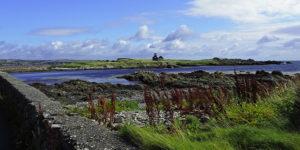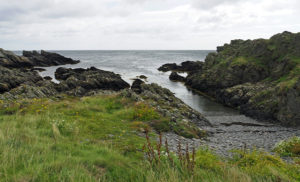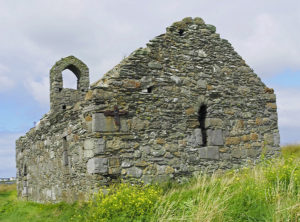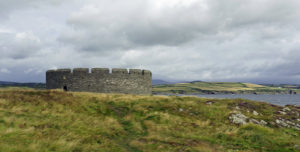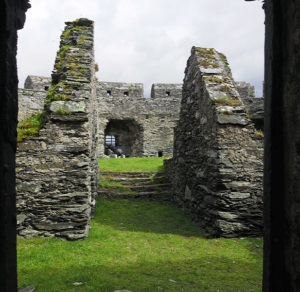On a fine sunny day this is a lovely “walk”:https://www.visitisleofman.com/things-to-do/railway-ramble-castletown-derbyhaven-langness-st-michaels-island-p1299561 from Castletown to the tiny island off the northern tip of the Langness Peninsula. Also known as Fort Island, this is now connected by a causeway and is a popular spot for dog walkers.
The walk begins along the A12 from Castletown to Derbyhaven along the shore of Castletown Bay and past King William’s College.
Above the shore is “Hango Hill”:https://www.silvertraveladvisor.com/review/attraction/199726 , which has its origins in the Norse for ‘Gallows Hill’. The site has been used for executions since Medieval times but is best remembered as the place William Christian, (Illiam Dhone) was executed in 1663 for his part in surrendering the Royalist-held Island to Parliamentary forces in 1651. The building remains on top of Hango Hill are nothing to do with the site of execution and are the remains of a late C17th summerhouse built by the Earls of Derby after the execution of William Christian. It seems to have been linked to horse races organised by the Earl along the dunes on he east side of the Langness Peninsula. Much of the building has been eroded by the sea.
Derbyhaven is a small settlement clustered round the safe anchorage of Derby Haven. In the C17th this was a significant port, providing better shelter than Castletown. Now it is used by small pleasure boats and is overlooked by Ronaldsway Airport. This is a good place for plane spotting.
A rough track follows the shore past the golf course and club house (good cakes in the “cafe”:https://www.silvertraveladvisor.com/review/restaurant/199491-review-langness-no-19 ) and a long disused hotel to St Michael’s Island. This was linked by a stone causeway built in the late C19th.
The island is a low lying windswept area, which needs to be visited on a dry day as there is no shelter. It is popular with dog walkers with mown grass paths through the rough vegetation. It has a very sharp jagged coastline although there is one small harbour area to pull up boats.
There are the ruins of a Norse-Celtic chapel on the south of the island. This dates from the C12th,but may have been built on the site of an earlier keeil. It was dedicated to St Michael and is a small rectangular building built of local stone (limestones, volcanic conglomerate and shore boulders set in mortar) with a small bellcote. The door is now barred by a metal grille. The holes by the door suggest that it could have been secured from the inside in times of danger. There are no records of when this stopped being used.
It would have been surrounded by a burial ground enclosed by an earth bank and stone walls, although no sign of this is left. It was in use until the 1870s, mainly for shipwreck victims and the small Roman Catholic community at the south of the island.
The large stone circular structure at the tip of the island is Derby Fort. A fort was built here in 1540 by the 3rd Earl of Derby as part of Henry VIII’s system of coastal defences against invasion by the Scots or French. It provided a secure base for a garrison of six. It had thick walls with a rampart walk, a single entrance and 8 gun points.
The fort was refurbished by James, 7th Duke of Derby during English Civil War as part of his upgrading of the island defences by increasing the defenses on the west and north to protect Castle Rushen and the safe anchorage of Derby Haven from Parliamentary troops.
By the C18th, the fort was no longer needed and became a lighthouse and was used by the herring fleet.
For those feeling energetic, it is possible to “extend the walk”:http://www.visitisleofman.com/things-to-do/derbyhaven-and-langness-nature-walk-p1315501 round the rest of the Langness Peninsula.
